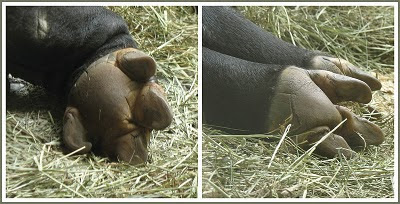Today my post on Iemisch was commented by Alan Lowey, who wrote the following (I will quote the relevant parts):
(…) The toe configuration fits with that of an odd-toed ungulate (4 front, 3 back) the same as the Beast of Gevaudan etc imo. Also fits with African Nandi Bear suggesting a common ancestor before the continents parted some 110 million years ago.
Perissodactyla – odd-toed ungulates
Perissodactyla (from the Greek words perissos abundant and daktulos toes), is an order of hoofed mammals that comprises three families: Equidae (horses), Tapiridae (tapirs), and Rhinocerotidae (rhinoceroses). There were more families, 15 in total, but they became extinct. [1]
The interesting point is that there is an extant odd-toed ungulate living in South America, it belongs to the family Tapiridae , which is “ the closest family to the ancestral perissodactyl condition - possess four toes on the forefeet […] and three on the hind” [5]
Patagonian Tapir, would be an odd-toed animal
I have posted on the hypothesis (a view first put forward by me – as I have not seen it postulated by anybody until now) that the tapir reported by many of the first explorers may be an unknown species within the Tapiridae and can actually explain many of the pig, hipoppotamus or cow/bull shaped aquatic cryptids found in the native and contemporaty myths and reports on Patagonian lake “monsters”.
I posted on this in a three separate entries on the Patagonian Tapir.
Of course, there are no known tapir in Patagonia. But if there presence there could be proved, it may explain many lake creature sightings.
As the photograph below shows, it has 3 toes and 4 toes on its hooves, just like the Iemisch "water tiger" beast:
Undersides of the front (left) and back (right) hooves of a Malayan tapir at rest.
By Sasha Kopf [4].
By Sasha Kopf [4].
I was unaware until now of this fact (the number of toes on tapir's hooves), and it seems to link both creatures together. I thank Mr. Lowey for his comment.
No Patagonain chalicotheres?
Just as my commentator indicates, some cryptozoologists have suggested that the African cryptid, the Nandi Bear may be a carnivorouos species within the chalicothere family.[2]
These chalicotheres (now extinct), had long arms and very short legs which bore most of their weight. Like modern gorillas, some species “knuckle-walked” on their front paws, which had long curved claws. [3]
They could be found all over the world except South America, which means that our Patagonian cryptids are not chalicotheres.
But, as suggested by Lowey Iemisch, Nandi Bear and Beast of Gevaudan may share a common ancestor before the continents parted some 110 million years ago.
In the case that Iemisch and these Old world cryptids evolved from a common ancestor, the American side of the family, being a chalicothere, would not be related to Tapirs and there would be no need to postulate the existence of the Patagonian Tapir.
Tapir with talons
This proposed South American chalicothere may explain the strange tapir with talons reported in some parts of South America. A beast that could account for the aggressive predator behavior of certain Patagonian lake creatures. Common tapirs are not able to drag bullocks under water or behave violently like the Iemisch because they are not fierce carnivores.
However Captain FitzRoy wrote about a strange kind of tapir that was mentioned to him by Rodriguez, the commandant of the Bahia Blanca garrison in 1833. Rodriguez told him that in Paraguay he had seen:
a 'gran bestia,' [great beast] not many months old, but which then stood about four feet high. It was very fierce, and secured by a chain. Its shape resembled that of a hog, but it had talons on its feet instead of hoofs; the snout was like a hog's, but much longer. When half-grown, he was told that it would be capable of seizing and carrying away a horse or a bullock. I concluded that he must have seen a tapir or anta; yet as he persisted in asserting that the animal he saw was a beast of prey,* and that it was extremely rare.
- Neither of which remarks apply to the Anta.[6]
Bibliography.
[1] Nowak, R., (1999). Walker's mammals of the world. JHU. V.1 pp. 1007+
[2] Eaton, M., J., The Nandi Bear: Ferocious killer from the past
[3] Prothero, D., Schoch, R., (2002). Horns, tusks, and flippers: the evolution of hoofed mammals. Baltimore: JHU Press. pp. 249.
[4] Photos taken by Sasha Kopf at the Woodland Park Zoo,Seattle, Washington. This file is licensed under the Creative Commons Attribution ShareAlike 3.0 License. In short: you are free to share and make derivative works of the file under the conditions that you appropriately attribute it, and that you distribute it only under a license identical to this one.
[5] Order Perissodactyla. Odd-toed ungulates
[6] FitzRoy, R., (1839). Op. Cit. v.ii. pp. 107.
Patagonian Monsters - Cryptozoology, Myths & legends in Patagonia
2010 International Year of Biodiversity
Copyright 2009-2010 by Austin Whittall ©


















No comments:
Post a Comment